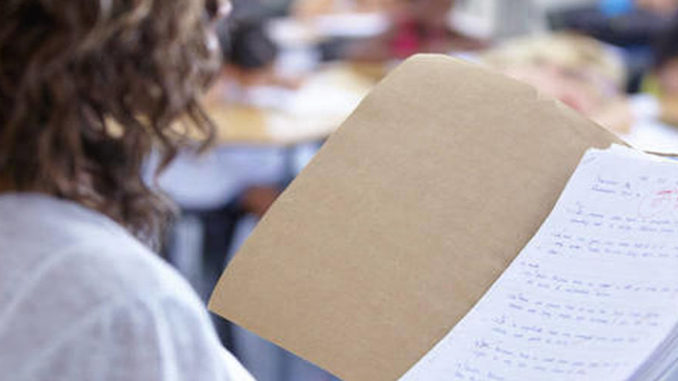
The results of the test, which assesses a sample of fourth- and eighth-grade students, will inevitably prompt demands for policy change.
by Erica L. Green and
America’s fourth and eighth graders are losing ground in their ability to read literature and academic texts, according to a rigorous national assessment released Wednesday that is likely to fuel concerns over student achievement after decades of tumult on the educational landscape.
Two out of three children did not meet the standards for reading proficiency set by the National Assessment of Educational Progress, a test administered by the National Center for Education Statistics, the research arm of the Education Department.
The dismal results reflected the performance of about 600,000 students in reading and math, whose scores made up what is called the “nation’s report card.” The average eighth-grade reading score declined in more than half of the states compared with 2017, the last time the test was given. The average score in fourth-grade reading declined in 17 states. Math scores remained relatively flat in most states.
Only 35 percent of fourth graders were proficient in reading in 2019, down from 37 percent in 2017; 34 percent of eighth graders were proficient in reading, down from 36 percent. Overall student progress in reading has stalled in the last decade, with the highest performers stagnating and the lowest-achieving students falling further behind.
Education Secretary Betsy DeVos on Wednesday called it a “student achievement crisis.”
“Think about the mom or dad who cannot read, and so does not read to their own children at bedtime,” Ms. DeVos said as she released the scores. “Think about what that portends for their lifelong learning.”
Ms. DeVos dismissed calls — including those from Democratic presidential candidates — to increase school funding to improve the worst-performing schools. She has championed programs that allow tax dollars to follow children to the schools of their choice, including private schools, religious schools and charter schools, and has rejected the view that more money would lift struggling schools.
Representative Rosa DeLauro, Democrat of Connecticut and chairwoman of the House subcommittee that oversees the Education Department’s budget, sharply disagreed.
Rather than “exploiting” the result of the test “to spread lies and promote her privatization agenda, Secretary DeVos should join House Democrats and families across our nation by supporting increased investments in our public education system,” she said.
School-district leaders and education advocates said the steep losses among the lowest-performing students reflected structural barriers beyond schoolhouses.
“This is a disturbing pattern, one that is consistent with our nation’s growing economic inequality and history of structural discrimination in education, housing, and access to opportunity,” said Mike Magee, the chief executive of Chiefs for Change, which represents state and district education leaders.
A growing body of research indicates that reading instruction is uneven across the country and often ineffective.
Peter Afflerbach, an expert on reading and testing at the University of Maryland, called the eighth-grade declines “troubling” and “precipitous,” especially for the lowest-achieving students.
Eighth graders at the bottom 10 percent of reading achievement lost six points on the exam compared with similar students two years ago, while students at the middle lost three points. Students in the top 10 percent lost only one point.
White, black, Hispanic, Native American and multiracial students all lost ground in eighth-grade reading, while there was no significant change for Asian students. Eighth grade is crucial because it prepares students for high school and beyond.
The most recent research on reading, Mr. Afflerbach said, has undermined a long-held view that children learn to read until the fourth grade, and then “read to learn” in higher grades. Because of that view, too many schools have assigned elementary students short passages instead of challenging them with longer, thematically rich texts and books.
The new eighth-grade results show “the students haven’t developed the reading comprehension to deal with text complexity,” he said.
Washington, D.C., was the only city or state to have significant improvement in eighth-grade reading, according to a federal analysis of the data. The District of Columbia Public Schools was the fastest-improving of 27 urban systems that participated in a separate analysis of large districts. It also demonstrated growth in fourth- and eighth-grade math.
Lewis D. Ferebee, the chancellor of the District of Columbia Public Schools, attributed the gains to a broad range of policies, including universal preschool, higher pay and performance bonuses for teachers, and home visits to help educators understand their students’ family contexts.
He also talked about “cornerstones” — the district’s effort to teach vocabulary and reading skills through shared experiences. Elementary students take lessons in how to safely ride a bike, and go on a field trip to Nationals Park, the city’s professional baseball stadium, where they run the bases.
“While that sounds super fun, embedded in that experience is a very rich literacy lesson,” Mr. Ferebee said.
He acknowledged, however, that the system still had work to do, especially in closing income-based achievement gaps.
Catherine Snow, a literacy expert at the Harvard Graduate School of Education, said educators need to learn how to integrate foundational reading skills, such as knowledge of letter sounds and combinations, into lessons that will excite young children.
“If the task you’re engaged in is researching lizards’ reproductive cycle or discussing who Harry Potter’s best friend was and why, those are intrinsically motivating tasks,” Ms. Snow said. “They drive you back to texts to find information.”
This year, eighth-grade reading scores in 31 states dropped two to seven points — which the federal government deemed significant — compared with their performances in 2017. Indiana, New Hampshire and Virginia had the largest declines. Fourth-grade reading scores dropped in 17 states, with New Jersey’s six-point drop the largest. Only one state, Mississippi, improved, the data showed.
James F. Lane, the superintendent of public instruction in Virginia, said that while grade-level proficiency was a goal, the school system “must also recognize that Virginia’s schools are enrolling increasing numbers of students whose learning is impacted by poverty and trauma.” He said the school system needed to recruit and retain high-quality teachers and equip them to meet the needs of a “changing student population.”
Average math scores fared considerably better, particularly among fourth graders. Nine states had significant increases in fourth-grade math, compared with 2017. Again, Mississippi led the pack. The eighth-grade score in three states improved, while those in six states declined.
American students have made large gains in math and small gains in reading since 1990. But those improvements began to level out around 2009. There is no consensus on why that happened.
The Council of the Great City Schools, a coalition of large urban school systems, said it saw a hopeful story in the new data. Over the past two decades, city students, who are more likely to be poor or not fluent in English, have moved closer to national achievement averages in both math and reading.
Some researchers consider the National Assessment of Educational Progress test to be the gold-standard measure of learning nationwide, but others argue it is unfair to judge schools using an exam that may have little connection to the material teachers cover in the classroom. In many cases, the federal exam is more challenging than state-level standardized tests.
“Someone has got to hold states accountable,” said Jim Cowen, the executive director of the Collaborative for Student Success, a group that defends the roles of standards and testing in public schools.
Erica L. Green covers education and education policy for the NY Times.
Dana Goldstein writes about how education policies impact families, students and teachers across the country for the NY timez. She is the author of “The Teacher Wars: A History of America’s Most Embattled Profession.”



